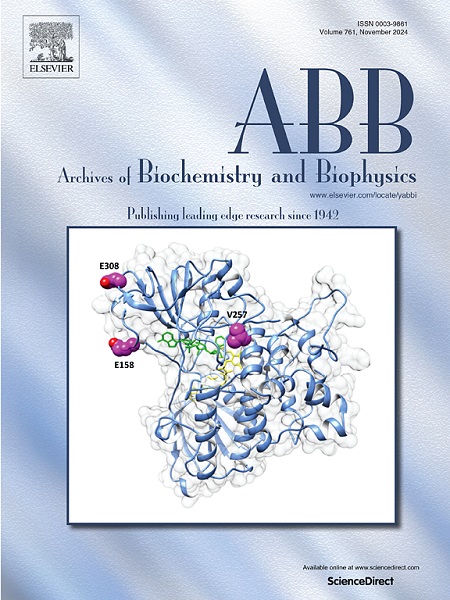MCF-7细胞中YAP复合物的化学计量学和亲和力的活细胞FRET测定。
IF 3.8
3区 生物学
Q2 BIOCHEMISTRY & MOLECULAR BIOLOGY
引用次数: 0
摘要
Yes-associated protein (YAP)是当前生物学研究的热点之一,它参与调节多种生命过程。在本报告中,利用活细胞荧光共振能量转移(FRET)成像来解开MCF-7细胞中的YAP复合物。共表达CFP(青色荧光蛋白)-YAP和YFP(黄色荧光蛋白)-LATS1(大肿瘤抑制因子1)质粒的活细胞荧光成像显示,YAP促进了线粒体周围LATS1的寡聚化。此外,FRET双杂交实验表明,YAP直接与LATS1相互作用形成二聚体。同样,我们发现YAP直接与大肿瘤抑制因子2 (LATS2)相互作用,在细胞质和线粒体周围形成1:2的异源三聚体。此外,YAP直接与血管运动素(AMOT)相互作用,在细胞质中形成异二聚体。然而,YAP不与O-linked N-acetylglucosamine transferase (OGT)相互作用。此外,FRET实验还表明,YAP与AMOT的亲和力较高,其次是LATS1,与LATS2的亲和力最低。综上所述,YAP直接与LATS1和AMOT相互作用形成异源二聚体,与LATS2形成1:2的异源三聚体,并且优先结合AMOT,其次是LATS1,最后是LATS2,这为Hippo-YAP信号通路提供了新的认识。本文章由计算机程序翻译,如有差异,请以英文原文为准。

Live-cell FRET assay on the stoichiometry and affinity of the YAP complexes in MCF-7 cells
Yes-associated protein (YAP), a focal point of current biological research, is involved in regulating various life processes. In this report, live-cell fluorescence resonance energy transfer (FRET) imaging was employed to unravel the YAP complexes in MCF-7 cells. Fluorescence imaging of living cells co-expressing CFP (cyan fluorescent protein)-YAP and YFP (yellow fluorescent protein)-LATS1 (large tumor suppressor 1) plasmids revealed that YAP promoted LATS1 oligomerization around mitochondria. Moreover, FRET two-hybrid assay showed that YAP directly interacted with LATS1 to form dimer. Similarly, we found that YAP directly interacted with large tumor suppressor 2 (LATS2) to form a heterotrimer with 1:2 in cytoplasm and around mitochondria. In addition, YAP directly interacted with angiomotin (AMOT) to form a heterodimer in cytoplasm. However, YAP did not interact with O-linked N-acetylglucosamine transferase (OGT). Furthermore, FRET assay also indicated that YAP exhibited a higher affinity with AMOT, followed by LATS1, and least with LATS2. In summary, YAP directly interacts with LATS1 and AMOT to form a heterodimer, with LATS2 to form a heterotrimer with 1:2, and shows a preference for binding to AMOT, followed by LATS1, and lastly LATS2, providing new insights into the Hippo-YAP signaling pathway.
求助全文
通过发布文献求助,成功后即可免费获取论文全文。
去求助
来源期刊

Archives of biochemistry and biophysics
生物-生化与分子生物学
CiteScore
7.40
自引率
0.00%
发文量
245
审稿时长
26 days
期刊介绍:
Archives of Biochemistry and Biophysics publishes quality original articles and reviews in the developing areas of biochemistry and biophysics.
Research Areas Include:
• Enzyme and protein structure, function, regulation. Folding, turnover, and post-translational processing
• Biological oxidations, free radical reactions, redox signaling, oxygenases, P450 reactions
• Signal transduction, receptors, membrane transport, intracellular signals. Cellular and integrated metabolism.
 求助内容:
求助内容: 应助结果提醒方式:
应助结果提醒方式:


